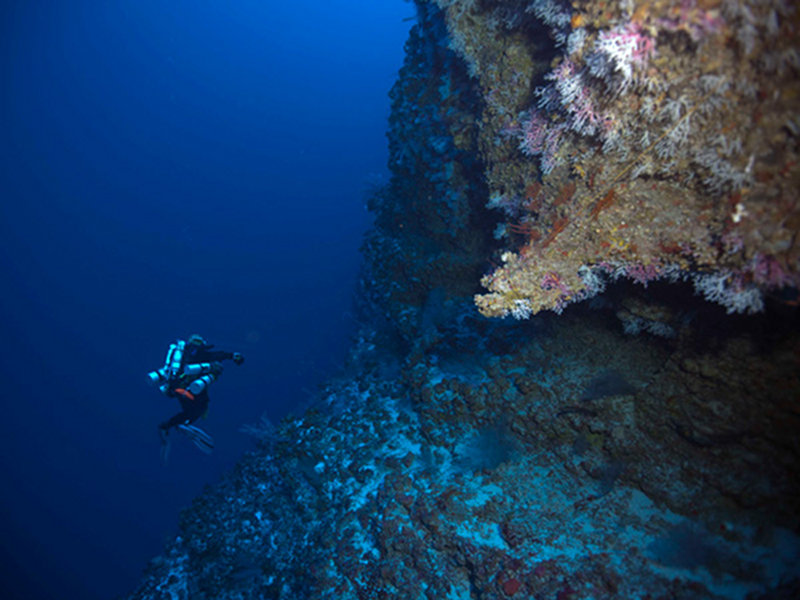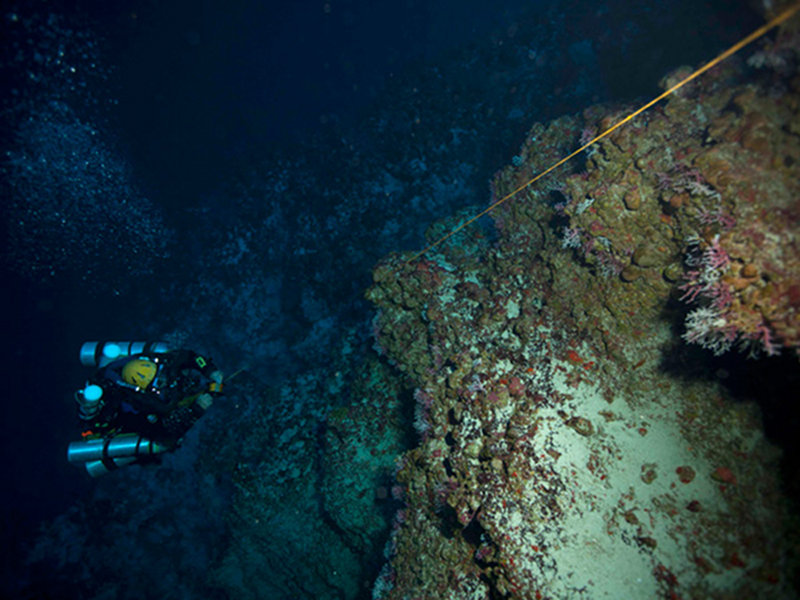
By Jill Heinerth, Underwater Videographer - www.IntoThePlanet.com
June 19, 2011
Jill Heinerth and Brian Kakuk suit up and dive on Challenger Seamount, reaching depths of over 400 ft while collecting samples and searching for marine caves. Video courtesy of Bermuda Deep Water Caves, NOAA-OER. Download (mp4, 48.4 MB).
On June 18, 2011, Brian Kakuk and I conducted the deepest manned SCUBA dive ever completed in Bermuda. Using equipment that looks more like a space suit than scuba gear, we plunged to 444 feet on the Challenger seamount and brought back biological samples and geologic treasures for scientists to examine. We also brought back a generous photographic record of our dive.
Breathing a helium-rich breathing gas, our closed circuit rebreathers (CCR) enabled the recycling of precious gas supplies. I was diving with my Sentinel CCR from VR Technology and Brian was using a Megalodon from Innerspace. We are both extremely conservative divers and wanted to maximize the available bailout gas (extra gas carried offboard in the event of a rebreather failure) by carrying four tanks each. We had 160 cubic feet of 10/50 oxygen/helium (10% oxygen content, 50% helium and remainder of gas content being nitrogen) in two tanks, an intermediate bailout of EAN31 (Enriched Air Nitrox having 31 % oxygen and 69% Nitrogen) and a tank of pure oxygen. Onboard, we carried 10/50 and oxygen in our two cylinders. Between the CCRs, bailout, accessory collecting equipment and my camera setup, that left us with over 250 pounds of equipment each.

Brian Kakuk collects samples around Challenger seamount. Image courtesy of Jill Heinerth, Bermuda Deep Water Caves 2011 Exploration, NOAA-OER. Download larger version (jpg, 669 KB).

Brian Kakuk reeling back to starting point from depth. A reel was used to lead the deep diving team back to the mooring line. Image courtesy of Jill Heinerth, Bermuda Deep Water Caves 2011 Exploration, NOAA-OER. Download larger version (jpg, 619 KB).
Our support team of Gil Nolan and Brett Gonzalez helped us dress on the transom while Graham Maddocks of Triangle Divers maneuvered into position at the marker buoy we had just deployed. Paul Heinerth played the role of deep safety and was fully dressed onboard in case of emergency. Nicolas Alvarado shot stills and video for the NOAA website and hyperbaric physician David Wakeley stood ready to assist. First Mate Marcus Cooper handling moorings and communications with Alex Chequer who stood ready on the fast boat provided by the Bermuda Institute of Oceanographic Sciences. It takes a large support team to make a safe and successful dive.
I slipped into the water first while Brian dressed on the back deck. I slid below the surface to prepare my camera at 15 feet and wait for a final bubble check. A school of Almaco Jacks and three very large wahoo zipped by to check me out. I was a little concerned that they could be the opening act for a circus of large pelagics.
We met for a final check and plunged for the bottom as fast as we could. We reached 350 feet in less than 6 minutes. The weighted line was dangling on the edge of the sheer wall. Brian tied on a reel and dived for the depths.
Our plan was to find a cave opening that was expected around 420 feet. An ROV image had shown an anchor line dangling over the entrance of the cave. We soon discovered that almost every Bermudian must have lost an anchor line on Challenger Bank since it was littered with lost rope. We found many small alcoves but no significant cave entrance. I stopped at 425 feet and Brian slipped down to 444 thinking he had seen our target. We could clearly see the 500-foot level where the wall reached a sandy ledge below us.

Brian Kakuk collects samples around Challenger seamount while looking for marine caves. Image courtesy of Jill Heinerth, Bermuda Deep Water Caves 2011 Exploration, NOAA-OER. Download larger version (jpg, 595 KB).
At max depth, Brian began feverishly collecting the samples requested by our science team while I shot photos and looked for dark volcanic rock. We worked our way back towards the mooring and shot a few more photos before heading up towards our first decompression stop. On these deep dives, the majority of time is spent decompressing in a series of stops up the line. We started deco [decompression schedule is the time the diver needs to spend at specific depths to allow gas (nitrogen or helium) diffuse out of the body without forming potentially lethal bubbles in the body] at 270 feet and eased our way up with a total dive time of over three hours. Brett met us at 100 feet and stayed with us for the duration of the dive.
The dive was completely smooth with the exception of the implosion of one of my pressure gauges from one of my bailout gas tanks. The tremendous pressure, equivalent to almost 14 atmospheres (1 atmosphere is equivalent to 33 feet of depth) was more than the structure could handle (pressure gauge cover was a plastic lens). I was thrilled that the deep modifications on my camera held out and the pictures came out beautifully. I caught a nap on the two-hour ride back to home base. It turns out that the cabin bench is far more comfortable than the bed I have been sleeping in at our cottage!